- Functional depth
- Salesforce is the CRM leader
- Salesforce ecosystem (training, integrations, etc.)
Our review of Salesforce
Salesforce is the global benchmark for CRM software. The solution is deployed in a large number of companies in France and abroad. In fact, knowing how to use Salesforce has almost become a must-have for joining a sales team.
My opinion
Customer reviews
- The software is quite expensive, especially for small businesses
- Not easy to learn at first
- The interface is cumbersome and sometimes unintuitive
Ideal for those looking for a powerful, comprehensive CRM solution with a wide range of functions
From 25 per user
Free 30-day trial
Sommaire
Salesforce is the global benchmark for CRM software. The solution is deployed in a large number of companies in France and abroad. In fact, knowing how to use Salesforce has almost become a must-have for joining a sales team.
Salesforce is an excellent CRM platform, but in my experience it’s not for every company.
The aim of this article is to help you decide whether Salesforce is the CRM for you or not: Salesforce is one of the most complete CRMs, but it’s not always the most suitable for relatively simple use, and you’ll need to rely on an integrator and probably Salesforce consultants to bring the project to a successful conclusion. And the more stakeholders you add, the longer and more expensive the project.
Sommaire
My opinion of Salesforce in a nutshell
Salesforce has long been the CRM solution to beat. This pioneering platform excels with an exceptional feature set and an ever-expanding set of innovations, including artificial intelligence, and easy integrations with a long list of business applications such as Slack, Facebook Ads, or resource management software.
However, Salesforce is a difficult fit for smaller organizations, especially because of the cost of implementation & the cost of the software itself.
| Perimeter | Score | My opinion |
|---|---|---|
| Overall rating | 4,5 | SFDC (Salesforce Dot Com) isn’t the market leader in commercial CRM software for nothing. The functional depth of the tool and the rich ecosystem of applications and integrators make it still a must-have solution. To be avoided if you’re not accompanied by experts: much simpler & lighter solutions will bring you a much better ROI. |
| Ease of use | 4,4 | It’s probably one of the most complex CRM programs to use, so rich is it, but Salesforce has made great efforts in terms of datavisualization. What’s more, the learning curve is relatively short, as almost all salespeople are familiar with it by now. |
| Easy to install | 4,2 | Salesforce is not a simple solution, and you might as well anticipate a high degree of complexity, and therefore integration costs. But today, most salespeople know the solution like the back of their hand, and Salesforce offers highly accessible training courses. |
| Customer service | 4 | For a very long time, Salesforce’s customer service was very disappointing, but they’ve clearly made a lot of effort in this area. Note, however, that this sometimes means investing in higher-paying plans. |
| Integrations | 4,7 | This is a major strength of the solution: the AppExchange marketplace is incredibly rich: whatever you want to add to your CRM, there’s an application, and a high-quality one at that. |
| Value for money | 4,6 | The Enterprise and Unlimited editions are the only options that really take advantage of Salesforce’s functional depth, and the list prices may seem prohibitive. The tool becomes really interesting for large organizations, with tailor-made plans and rates. |
Salesforce’s major strengths and weaknesses
- A very powerful CRM software. There is a reason why Salesforce has become a must-have software: from marketing tools to automation tools like Pardot, not only is everything there, but they are all of very high quality.
- The ability to choose the features that fit your needs, depending on your industry and the size of your business. The customization options are immense. TheAppExchange is ultra-complete.
- A recognized tool: Salesforce’s reputation means that your sales force, or those you’re about to recruit, probably already know how to use it, saving you time and the cost of Salesforce training.
- Einstein, the AI-based sales assistant: from lead assessment to sales forecasting, not to mention automated activity tracking, the breadth of Einstein’s sales tools and advice is pretty impressive.
- An expensive tool: Salesforce is quite expensive overall, especially since it is often necessary to integrate paid add-ons to access certain more advanced features. For novices, Salesforce costs and the pricing grid with the different modules are not very clear.
- A complex tool: powerful CRM means complicated configuration and installation and therefore a long learning curve. This also means you may need to call on the services of a Salesforce consultant or integrator.
- A busy interface: in terms of UX, Salesforce suffers from the comparison with lighter and more intuitive solutions. This inevitably slows down the deployment and daily use of the solution.
- Customer support: Salesforce has a bad reputation in this area, although overall their teams have made great strides and offer many technical support solutions, including training via Trailhead.
Try Salesforce for free
Salesforce offers a comprehensive demo video to give you an idea of the possibilities. To go into a little more detail and familiarize yourself (or not) with the interface, you can also request a free 30-day trial.
How much does Salesforce really cost?
There are 4 Salesforce plans, ranging from 25 euros/user/month to 300 euros. The Enterprise and Unlimited editions are the most comprehensive options, but are aimed at larger business organizations.
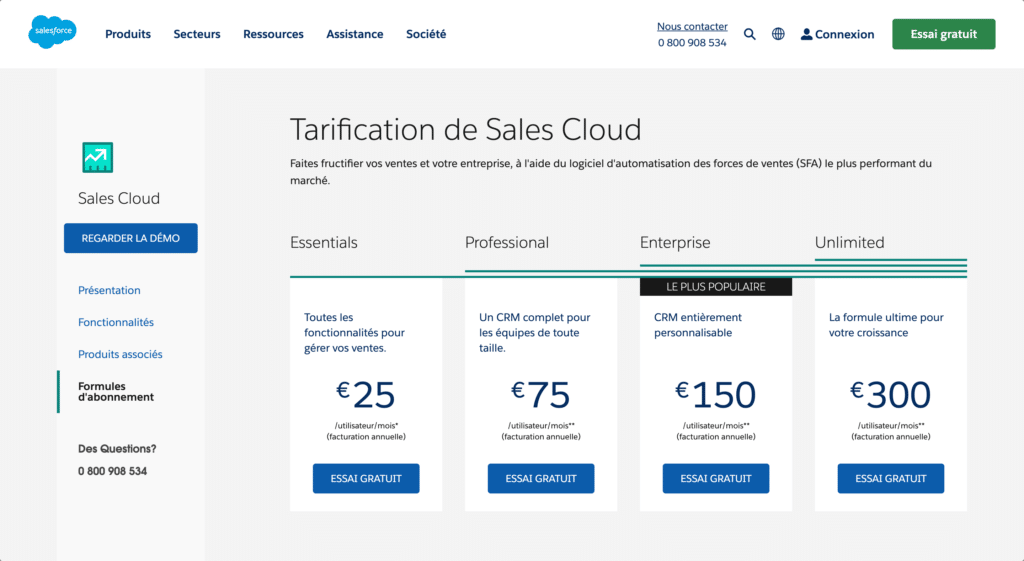
Even if Salesforce is quite flexible on pricing when user volume increases, be sure to reread the contract clauses in detail – in particular the annual price increase, and the terms of termination of the contract.
Salesforce details its various plans in this document.
In addition to licensing costs, there are a number of other costs to consider when implementing Salesforce.
Try Salesforce for free
If you can’t decide which plan is right for you, you can try Salesforce for free!
The cost of integration
Beyond the cost of Salesforce itself, when you deploy a CRM in your company you also need to consider the cost of integration. This is even more true for Salesforce given the complexity of the tool.
My advice
Find details of all Salesforce costs to consider.
It is estimated that Salesforce will cost at least €5,000 for a single user in the first year: so you could be paying up to €50,000 per year for a relatively small sales team.
This (wide) range varies depending on the following factors:
- The size of your organization: number of users, customers, transactions, etc.
- Your industry and business goals: depending on the level of customer engagement required, you will need a more complex CRM and will have to pay for additional modules.
- The type and complexity of your organization: The more complex your organization is (corporate structure, hierarchy, internal procedures, business processes, etc.), the more time-consuming and costly the Salesforce integration will be.
Salesdorado’s opinion
Let’s face it, Salesforce is one of the best CRMs on the market, but it’s also one of the most expensive. Whether Salesforce is too cumbersome for you, or you’re looking for a solution with a similar scope, you can find the 10 most credible alternatives to Salesforce here.
Salesforce features in detail
Commercial CRM: the heart of the software
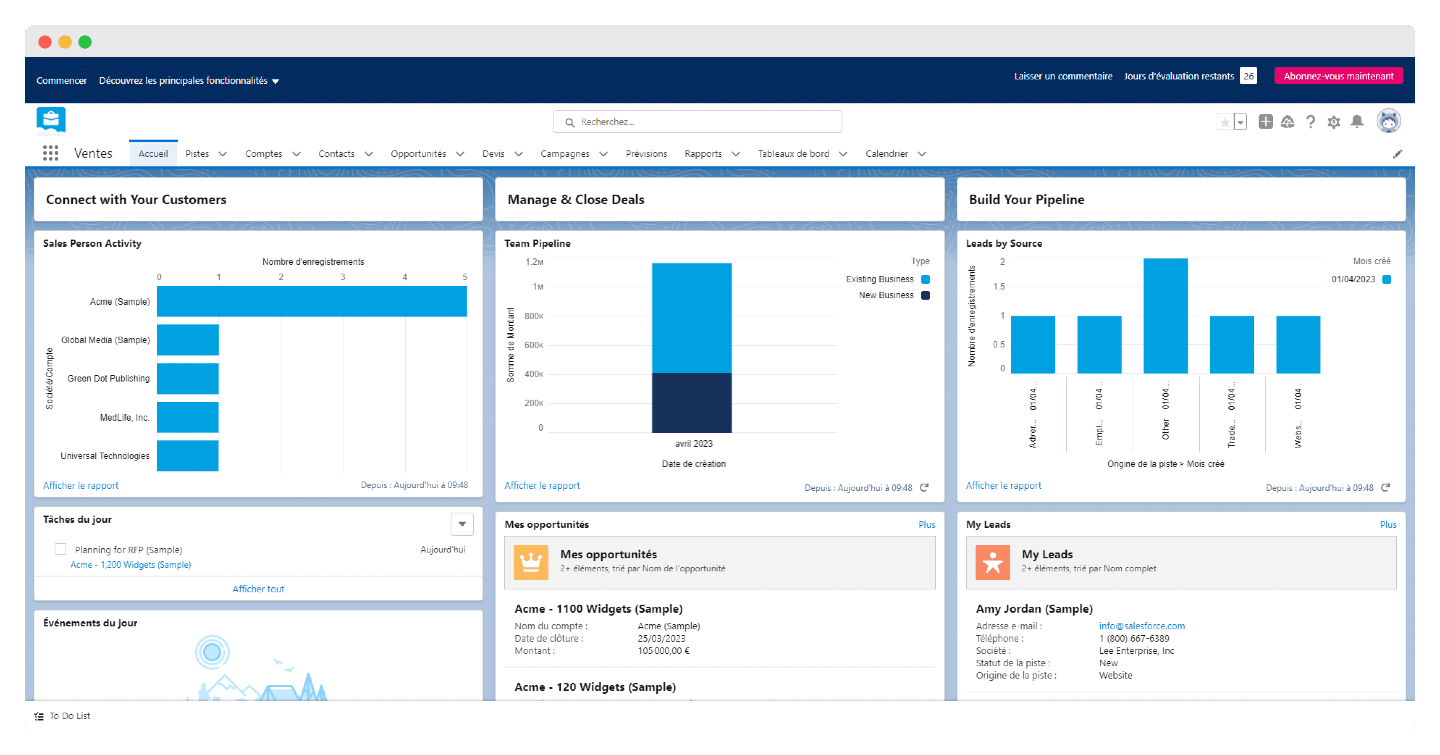
Opportunities and pipeline management
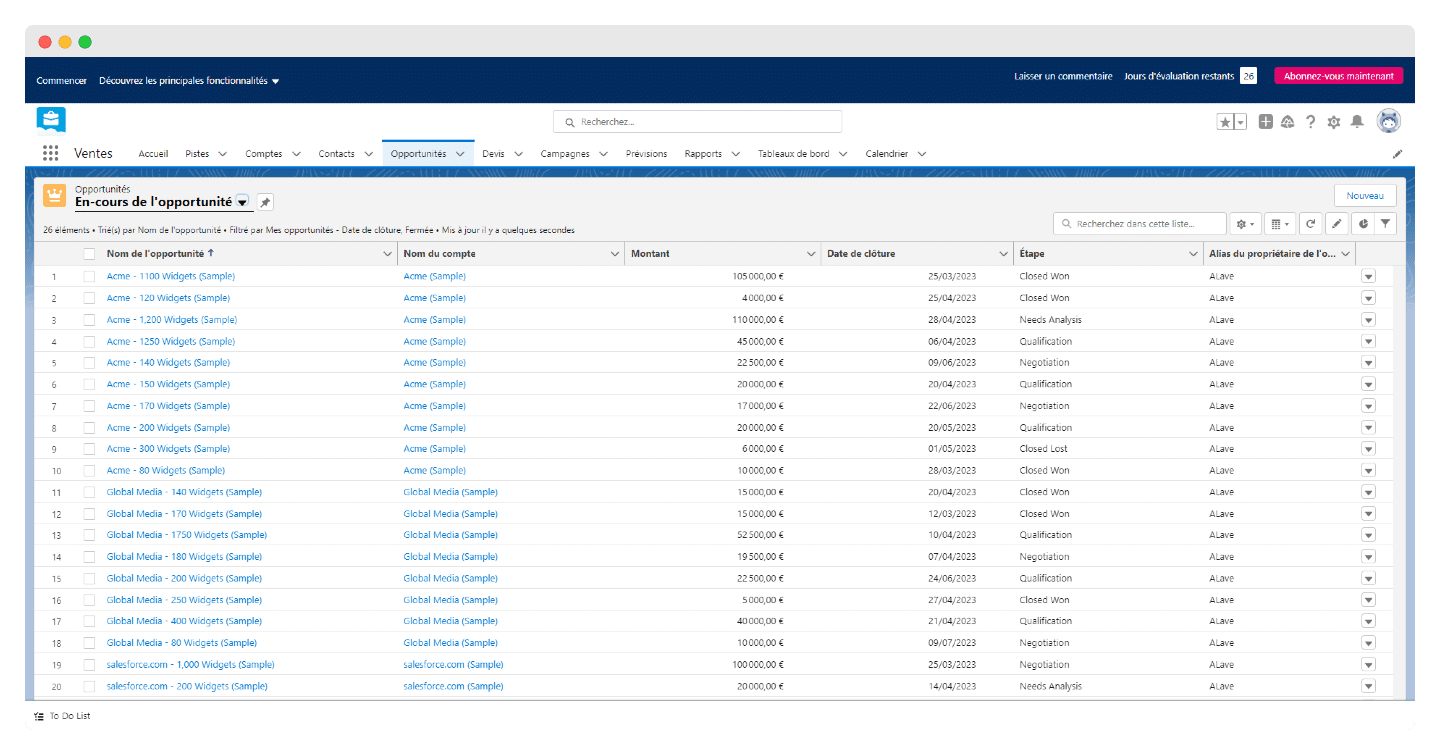
Track sales opportunities throughout their lifecycle – from lead to order confirmation. Sales pipelines can be tracked by an individual salesperson, teams, regions or across the company. These different entities track the progression of leads through your sales funnel and take action based on the potential value of the deals and the probability of closing.
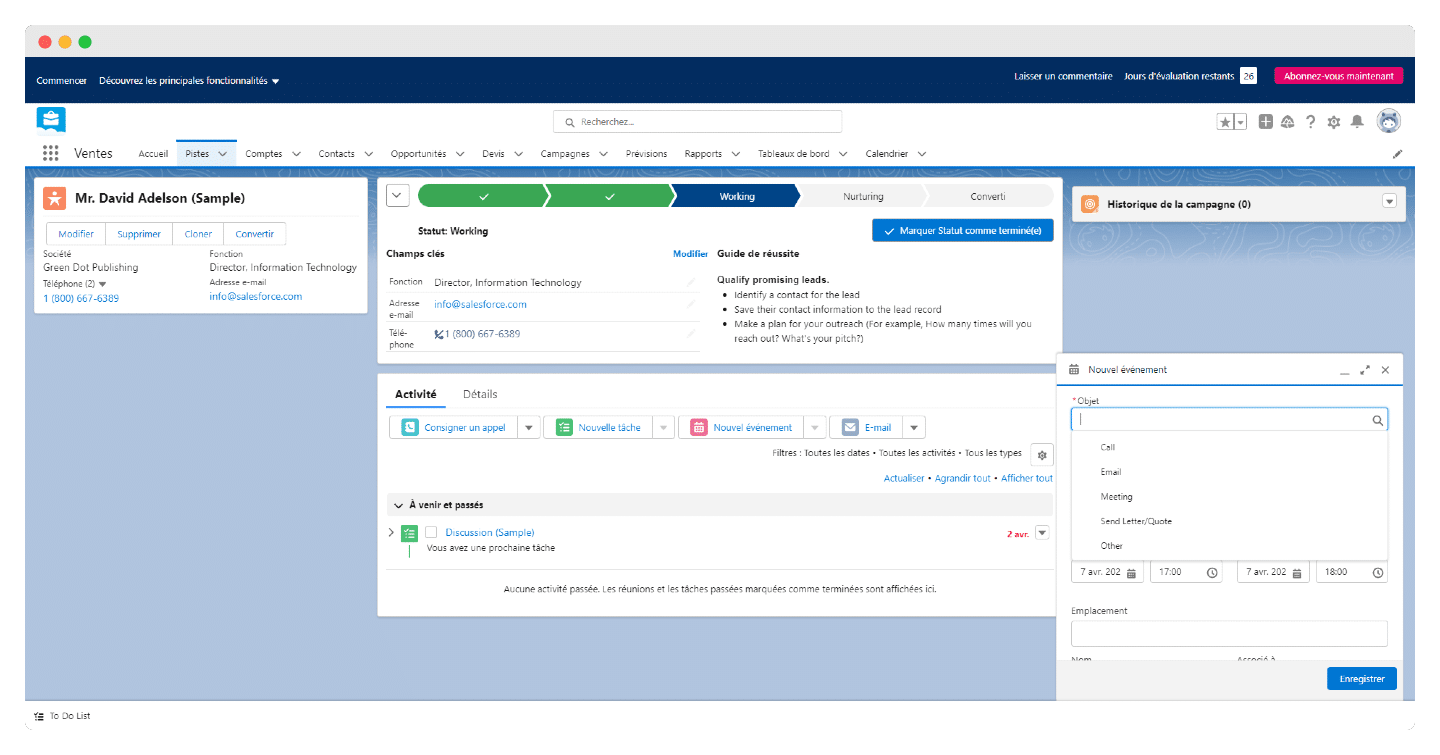
Management of relationships with partners
Manage partners by tracking channel partner leads and sales opportunities.
Tasks & activities
Assign due dates, set priorities, integrate tasks with calendar applications and manage your calendars.
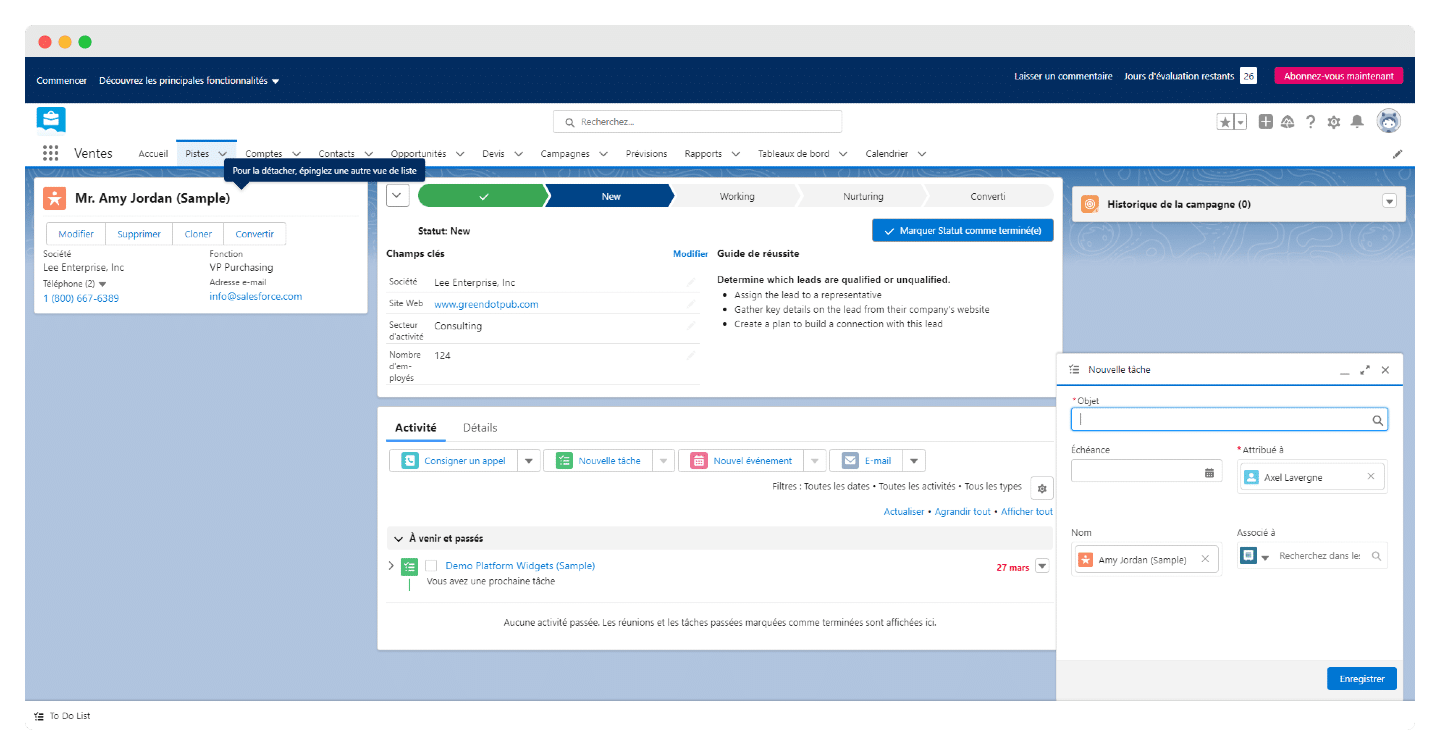
Contact and account management
Store and access contact information to improve the quality of marketing communications and messages. Track interactions to get an overview of your customers’ journey.
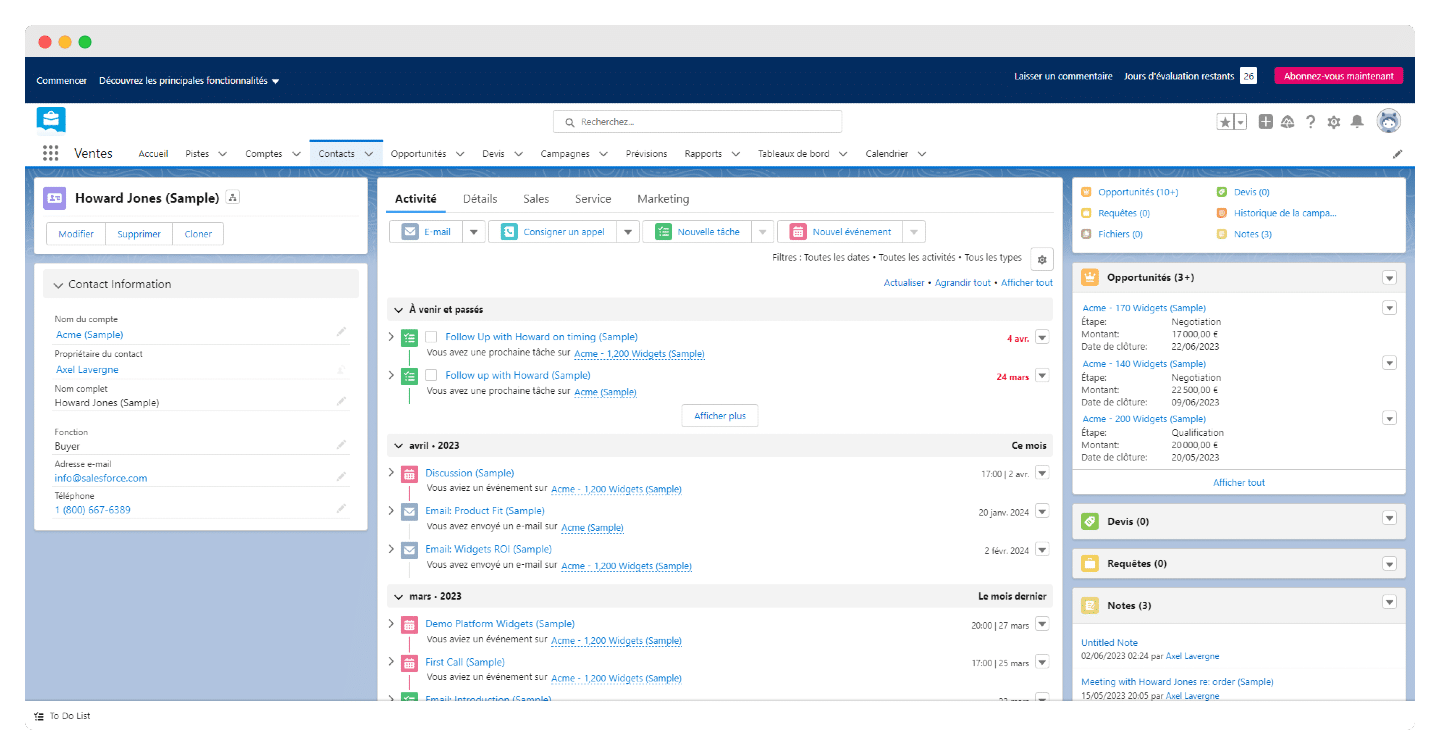
Contract management
Manage customer contracts, including negotiations, define contract terms and conditions and ensure compliance. Any changes made can be agreed upon and documented in the same place.
Product and Price Lists
Create and manage your product lists with pricing, including custom pricing and customer discounts if needed.
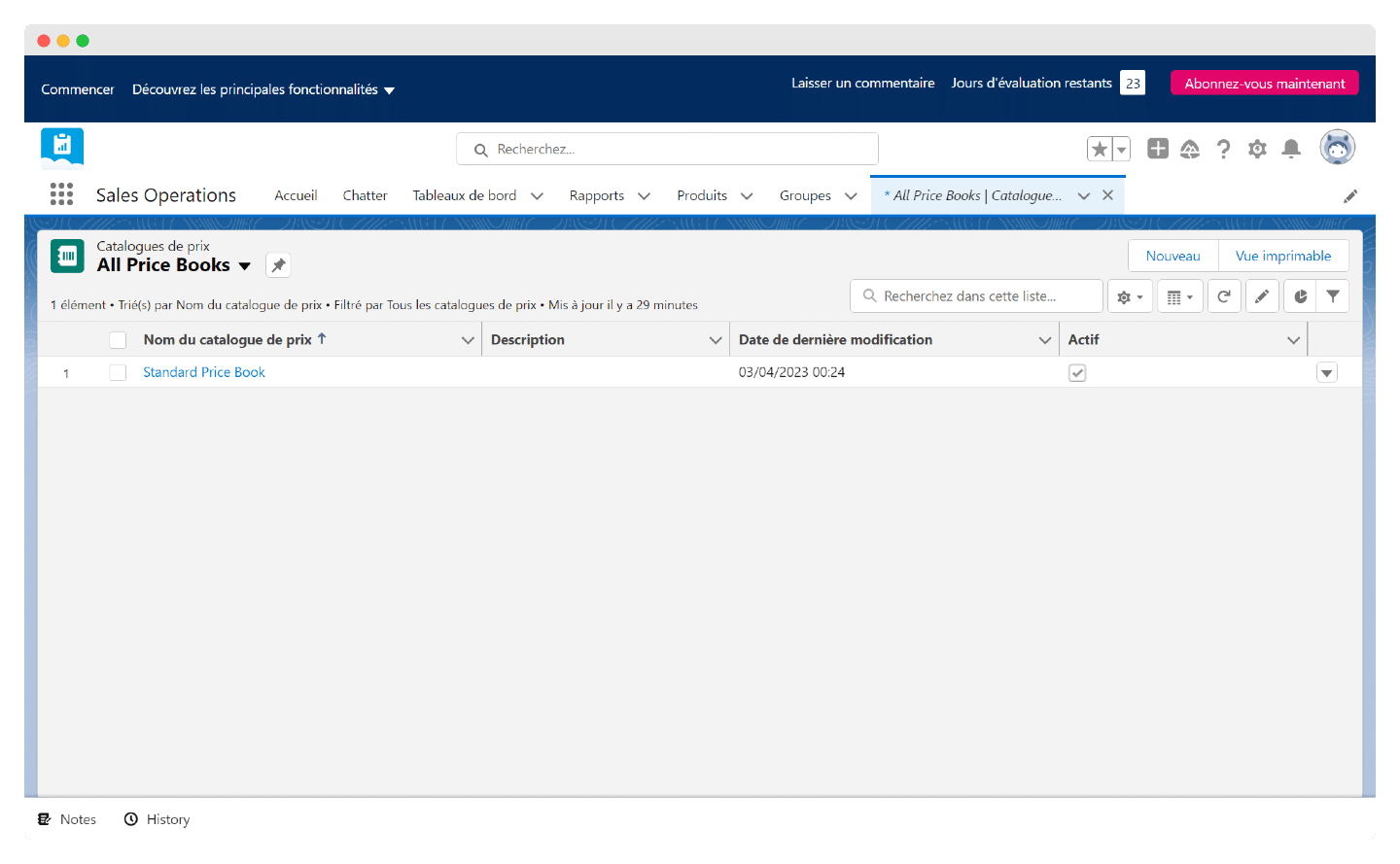
Quotes and orders
Quickly create quotes for your customers based on your product information and prices. Salespeople can also process orders when all required information is present – or assign orders to the appropriate department for fulfillment.
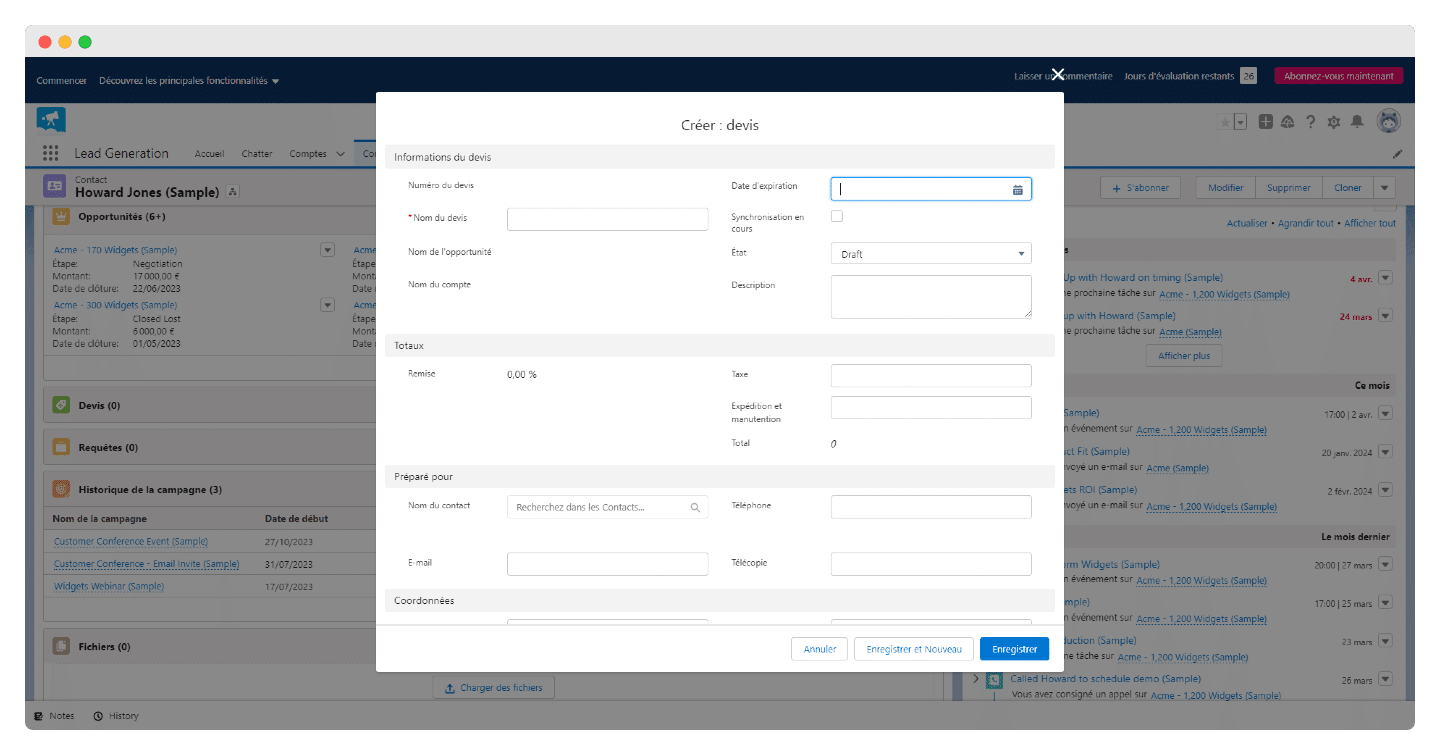
Try Salesforce for free
If the Salesforce world still seems complex to you, you can get a general idea of the different functionalities by testing the tool for free!
Lead management (CRM Marketing)
Sales and lead generation are two distinct applications, although they share a number of tabs (accounts, contacts, leads, etc.). The CRM marketing part is more targeted, with a tab to manage your marketing campaigns.
To prioritize your leads, Salesforce offers multiple views of your lead list, from the traditional chart to the Kanban, making it easy to move leads through your pipeline.
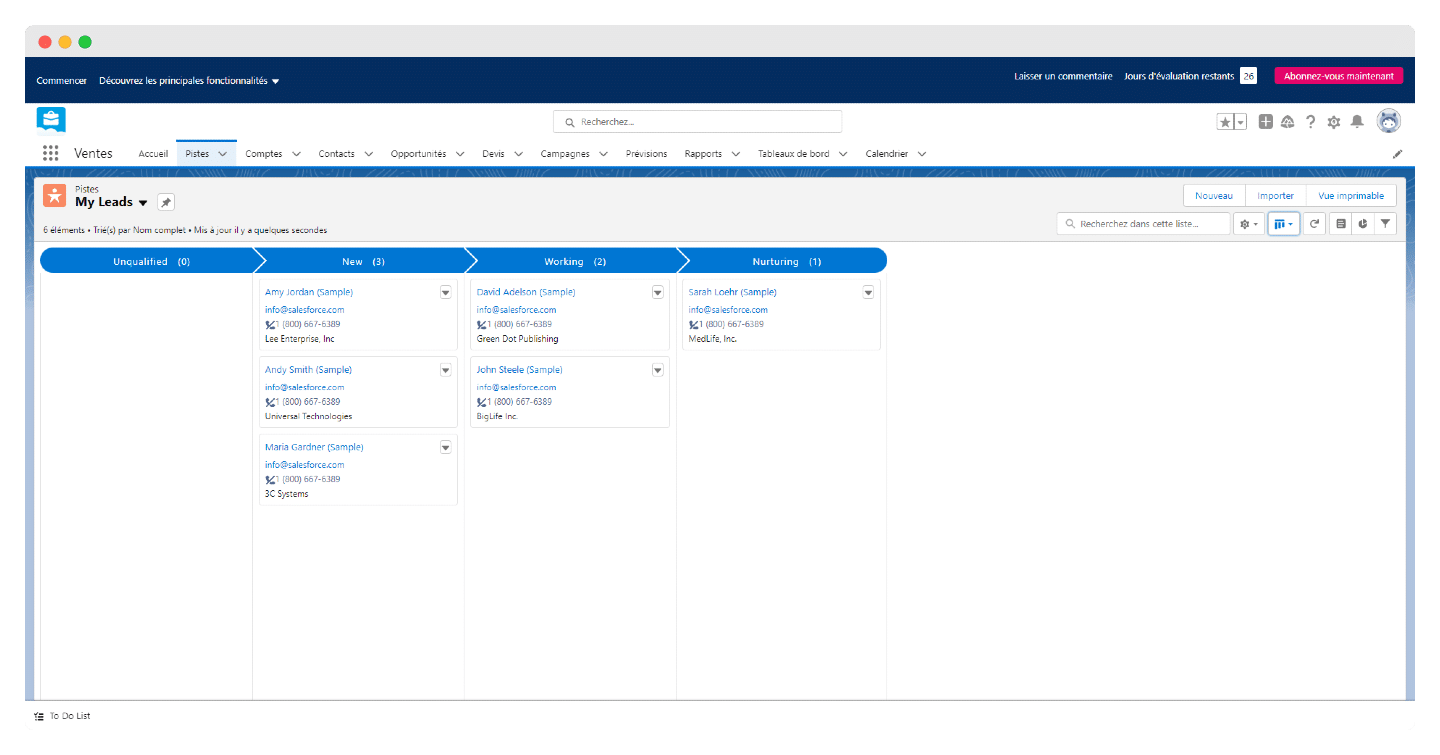
One of Salesforce’s strengths is the ability to analyze your leads using their Einstein AI tool to identify their potential for success based on your history: for Einstein Lead scoring to work, Salesforce recommends having created at least 1,000 leads in the last six months, with at least 120 conversions.
Customer tracking features on Salesforce
Here are the details of the features offered by Salesforce in terms of customer tracking:
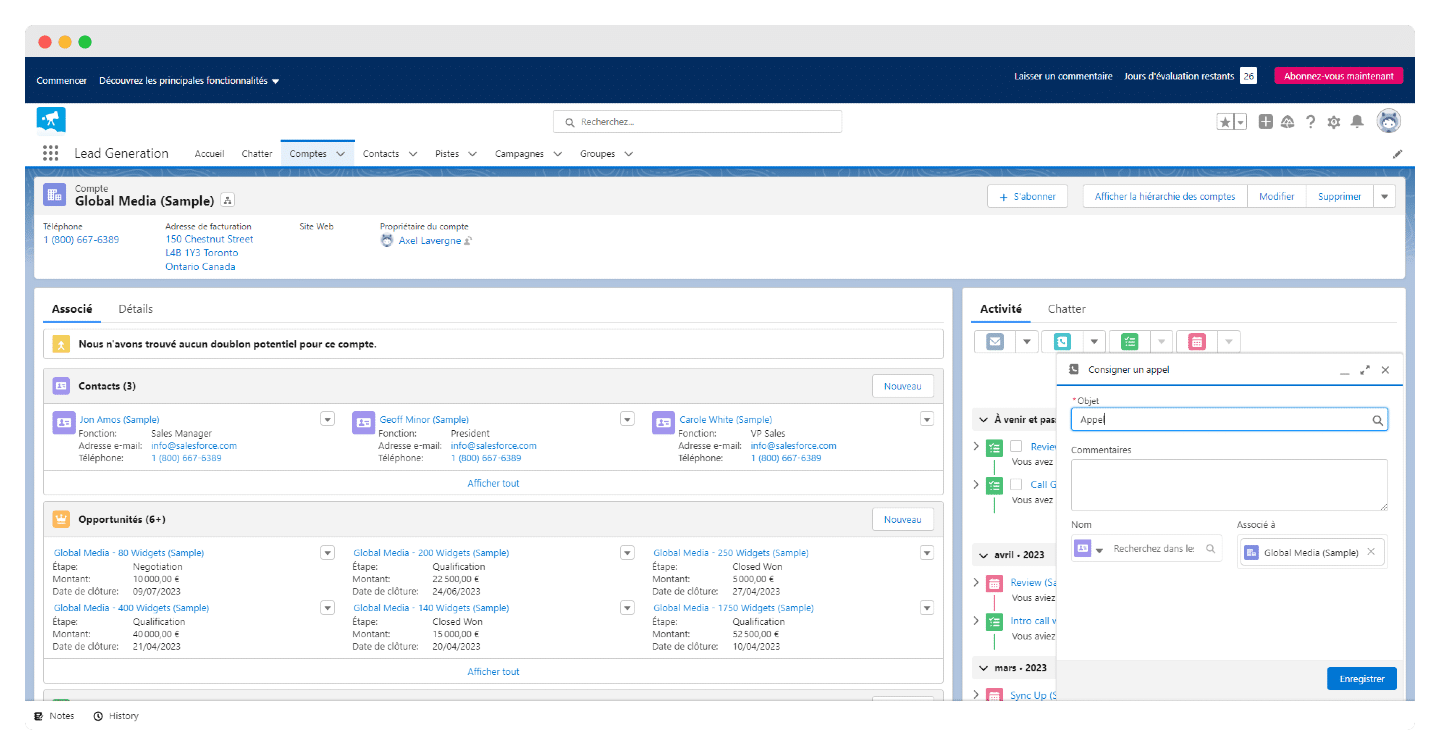
- Call center. Call recording, analysis, workforce management, call script management and compliance management.
- Problem management. Tracking of customer reported issues/help requests throughout the resolution process.
- Customer support portal. Provides your customers with a place to submit service issues, technical problems, place orders, view order history and contact your support team.
- Knowledge base. An information base where your customers can access all kinds of information about your products, services and other information they need to get the best experience possible.
- Analytics Support. Measure the performance of your customer support system and identify opportunities for improvement.
Salesforce is very complete in this respect, allowing you to provide a personalized message and follow-up to all of your customers, which is particularly effective when you use anAccount Based Marketing (ABM) approach.
Try Salesforce for free
We strongly recommend that you test Salesforce to get an idea of all its features!
The Salesforce App Exchange Ecosystem: Why It Matters
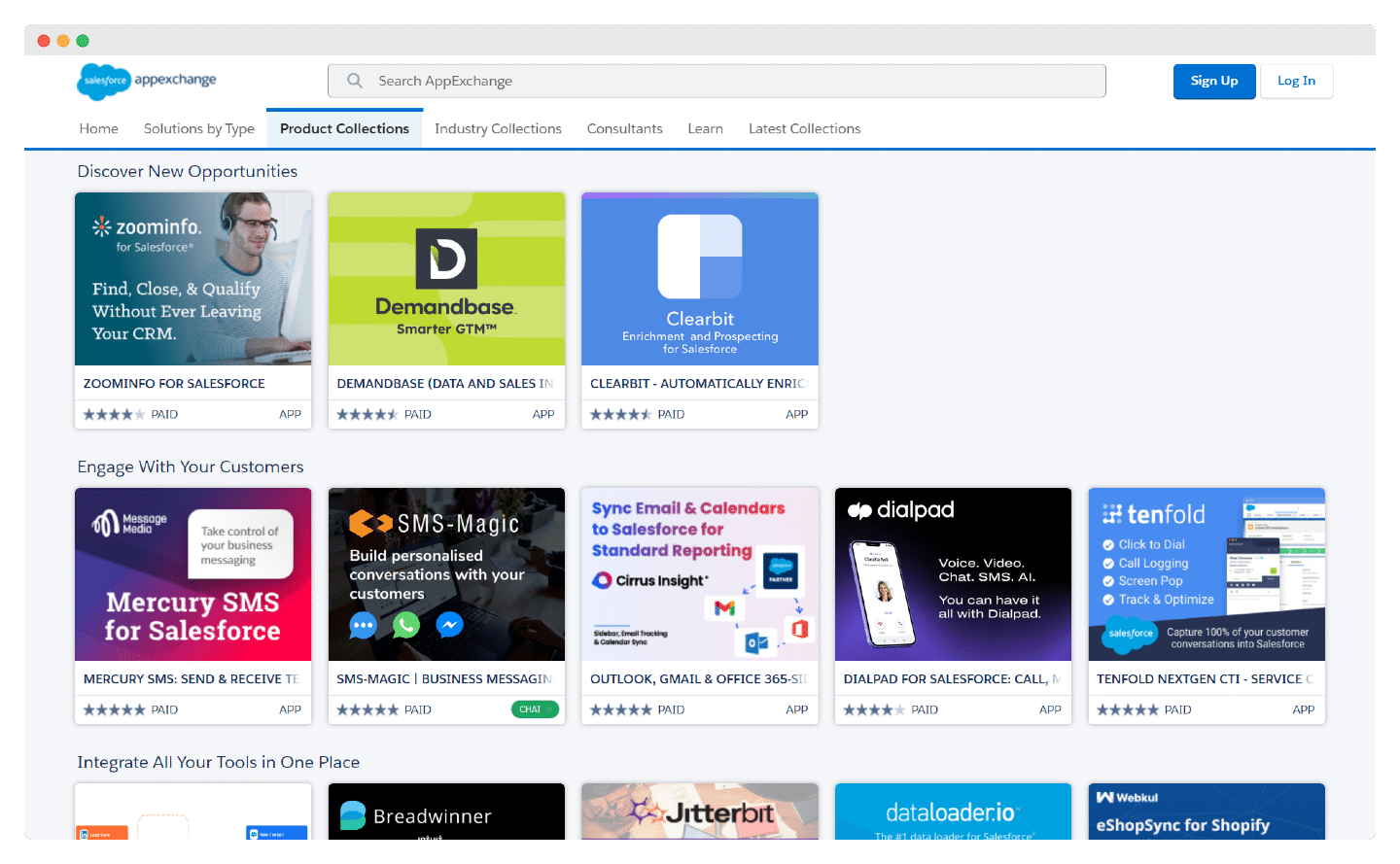
Salesforce is one of the largest third-party application marketplaces: the Salesforce AppExchange platform has been around since 2005 and gives you access to over 5,000 applications.
With the Professional, Enterprise and Unlimited plans, you also have a multitude of add-ons to add additional functionality.
For example, SalesforceIQ Inbox offers users a suite of productivity applications for mobile and desktop, including email and calendar integrations with smart contract and lead reminders.
Salesforce Billing allows for subscription renewals, contract renewals, and flexible billing.
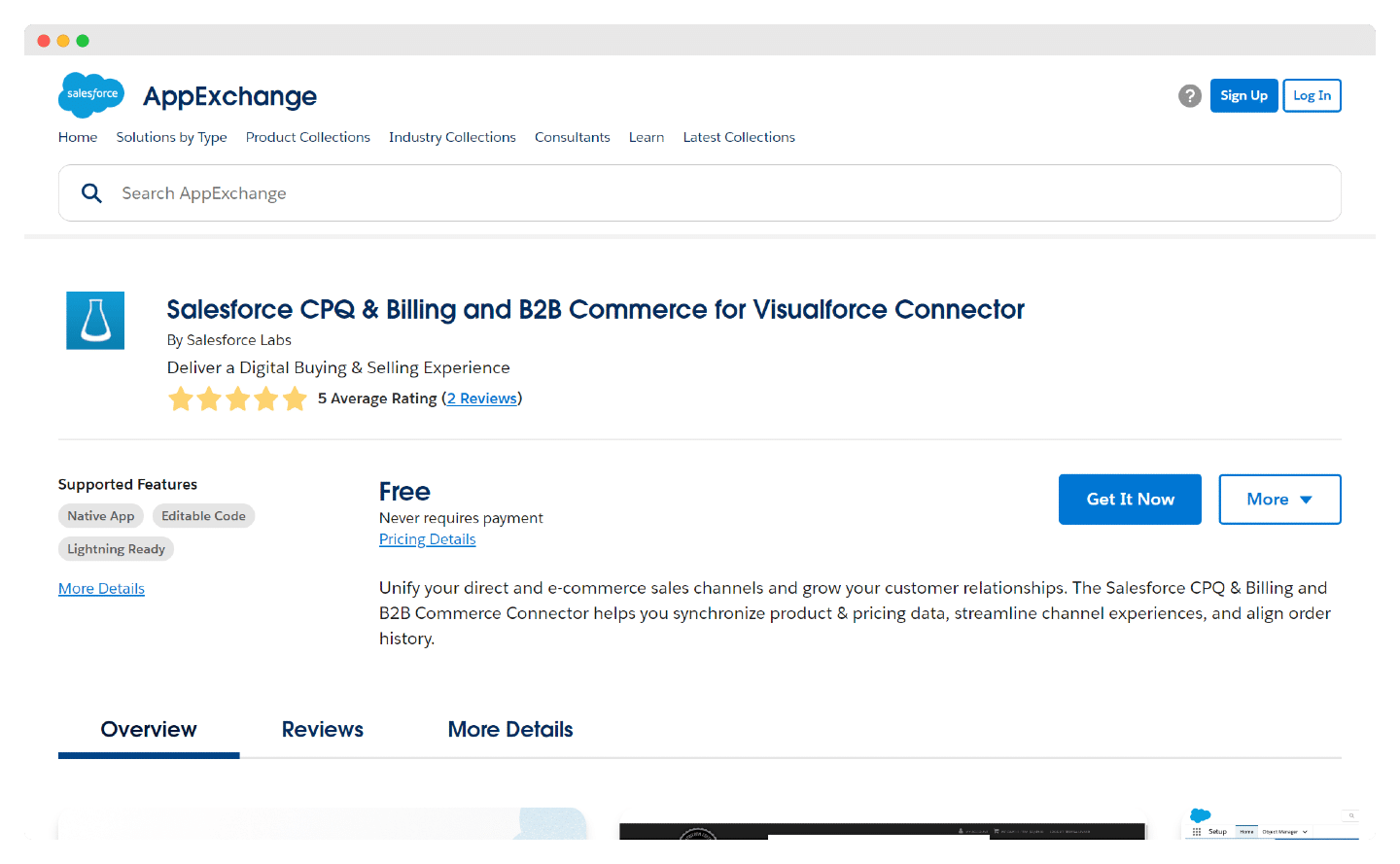
To collaborate, Salesforce offers its Chatter platform, which lets you share notes with colleagues or update the status of a project.
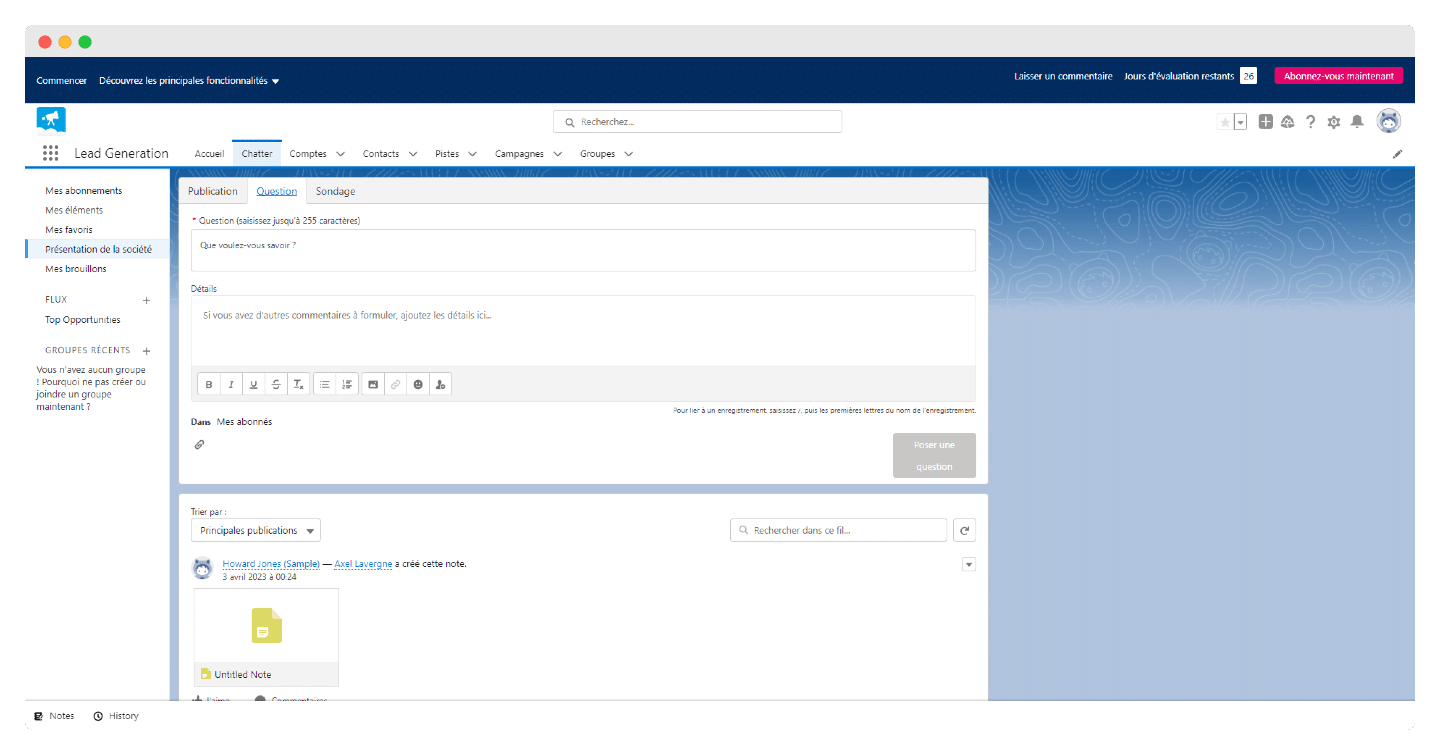
My advice
The AppExchange is one of the best on the market, but that means it can sometimes be a bit confusing. We recommend our top apps on the AppExchange.
Einstein
Salesforce is focusing on its Einstein Analytics artificial intelligence platform, which you can access from the Salesforce Lightning plan for an additional monthly subscription fee.
Artificial intelligence integrates with sales processes through dashboards that show quarterly or annual performance, risk indicators, but most importantly forecasts through its pipeline trend tracking functionality. For example, using Salesforce Lead Scoring to prioritize your opportunities.
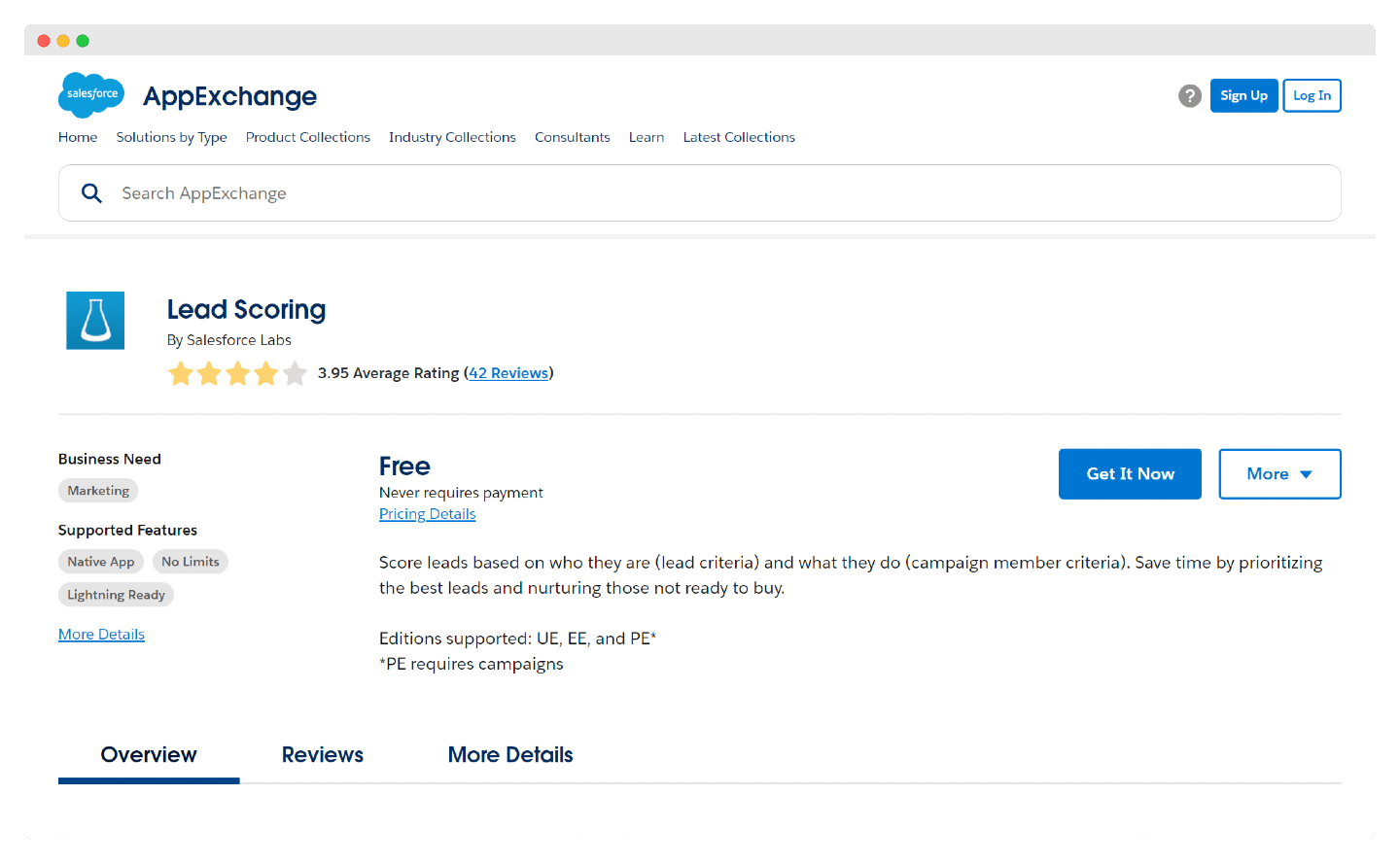
This Salesforce tool is truly one of the structuring benefits of CRM: it offers business intelligence and analysis, automates many tedious tasks, and provides access to detailed reports on every account, lead, or opportunity.
Add-ons
My advice
There are many, many features. And you may understand us a little better when we mentioned the possibility of getting “lost” in these features. For an effective deployment in your sales team, we highly recommend
- Use a Salesforce integrator.
- Provide your team with Salesforce training.
- Seek the advice of a specialized Salesforce consultant.
Salesforce CPQ (Configure, Price, Quote)
Salesforce CPQ is an automated quote generator for configuring products and prices for cross-selling, up-selling, contract and proposal generation, and invoice and payment processing.
My advice
Go directly to the Salesforce CPQ demo to see how this add-on can meet your needs.
Salesforce Marketing cloud engagement
The aim of Salesforce Marketing cloud engagement is to create the most optimal customer experience in order to win new customers or retain existing ones: to achieve this, Salesforce offers to automate your email campaigns, personalize your advertising, customize your conversational messaging, etc., and so on. These are just some of the tools available to streamline the customer experience.
Revenue intelligence
Salesforce’s Revenue Intelligence module uses the power of AI to analyze your sales and opportunities based on pipeline trends.
Try Salesforce for free
If you’re a little lost by the diversity of Salesforce’s features, we recommend you try out the tool for free to see how it can meet your needs.
Customer reviews of Salesforce
Users share our opinion on the main limitations of Salesforce:
- Salesforce is great for functionality and tailoring a platform to your needs, but the setup process can be a pain and the day-to-day use of the software is frustrating.
- If you’re looking for ease of use in sales and marketing tools, Salesforce feels like more of a hindrance than a help, which is especially hard to accept at this price point.
But if we have highlighted some of the limitations of this tool, it is still the leader in its market and not for nothing. Overall, users are satisfied with Salesforce and its ROI.
Try Salesforce for free
Test Salesforce for free and see for yourself!
Customer Support at Salesforce
Salesforce is the leader, and has built one of the most comprehensive, robust, and rich ecosystems of CRM software.
Salesforce integrators and consultants are numerous, highly competent (and vetted). If Oracle or Microsoft integrators are sometimes biased and much less controlled because they are outsourced sales forces for these CRMs, SFDC’s integrators keep their nose to the grindstone because Salesforce is the one that brings them business.
Salesforce does a monstrous job of training its partner ecosystem, with lots of certifications etc. Salesforce training, whether through their Trailhead platform or external providers, is very high quality.
The community and the help center are very rich, and SFDC has built an ecosystem of consultants, integrators, and experts who are there to help & implement the solution.
On the 100% Salesforce support side (offered by SFDC themselves), it’s pretty light. Without any specific investment, you have the Standard Success plan which gives you access to the community and all Salesforce content.
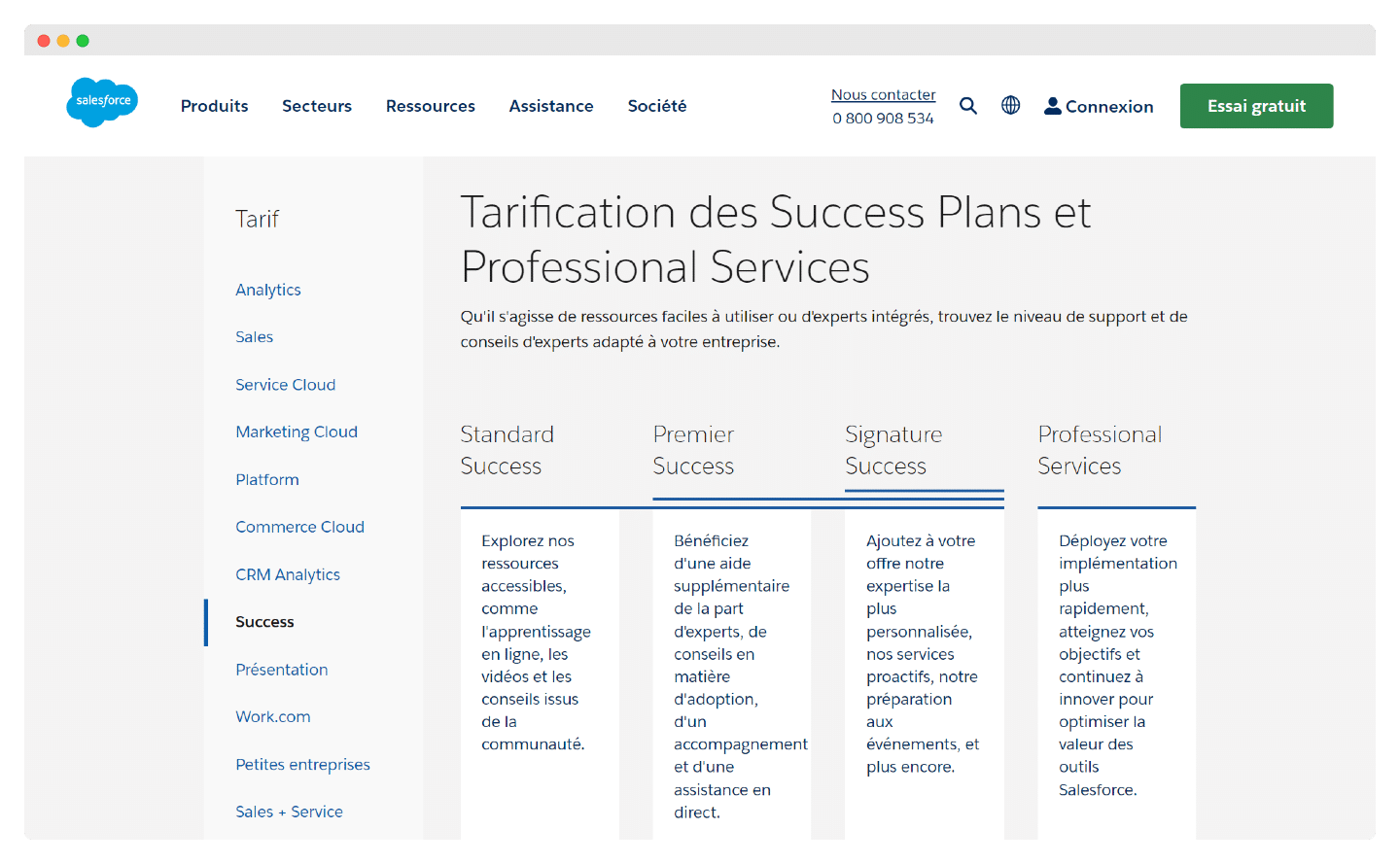
For more support, Salesforce offers paid plans: for 30% of the net license fee, you get access to the Premier Success plan and more in-depth customer support, which you can further expand with the Signature Success plan (price upon request).
Try Salesforce for free
Before we even talk about customer support, you can start by testing Salesforce for free to see if it works for you!

